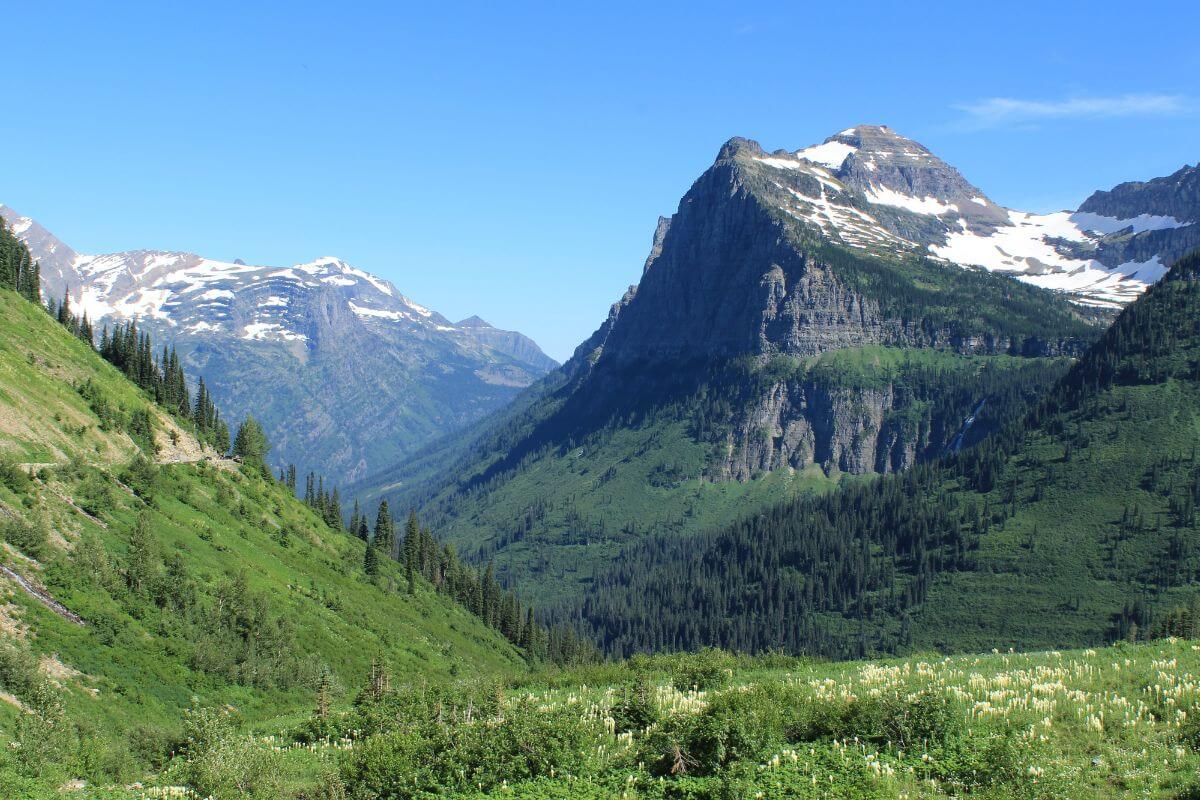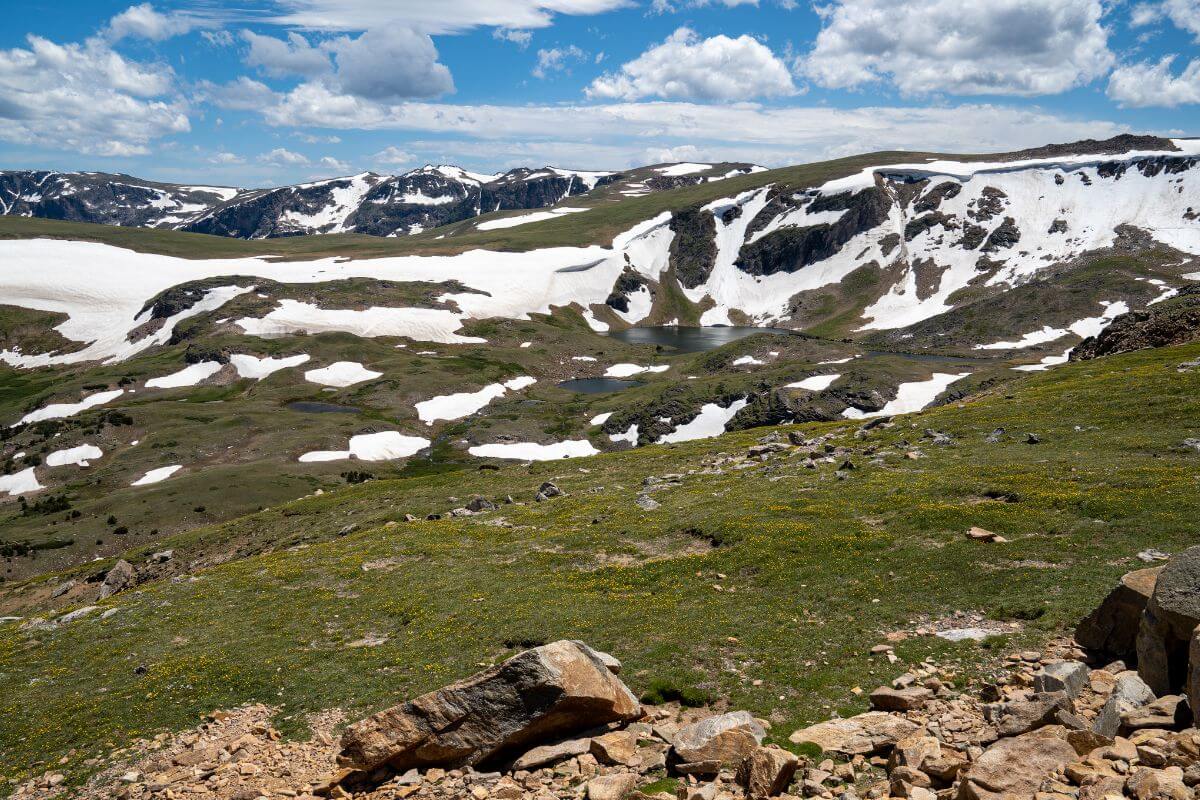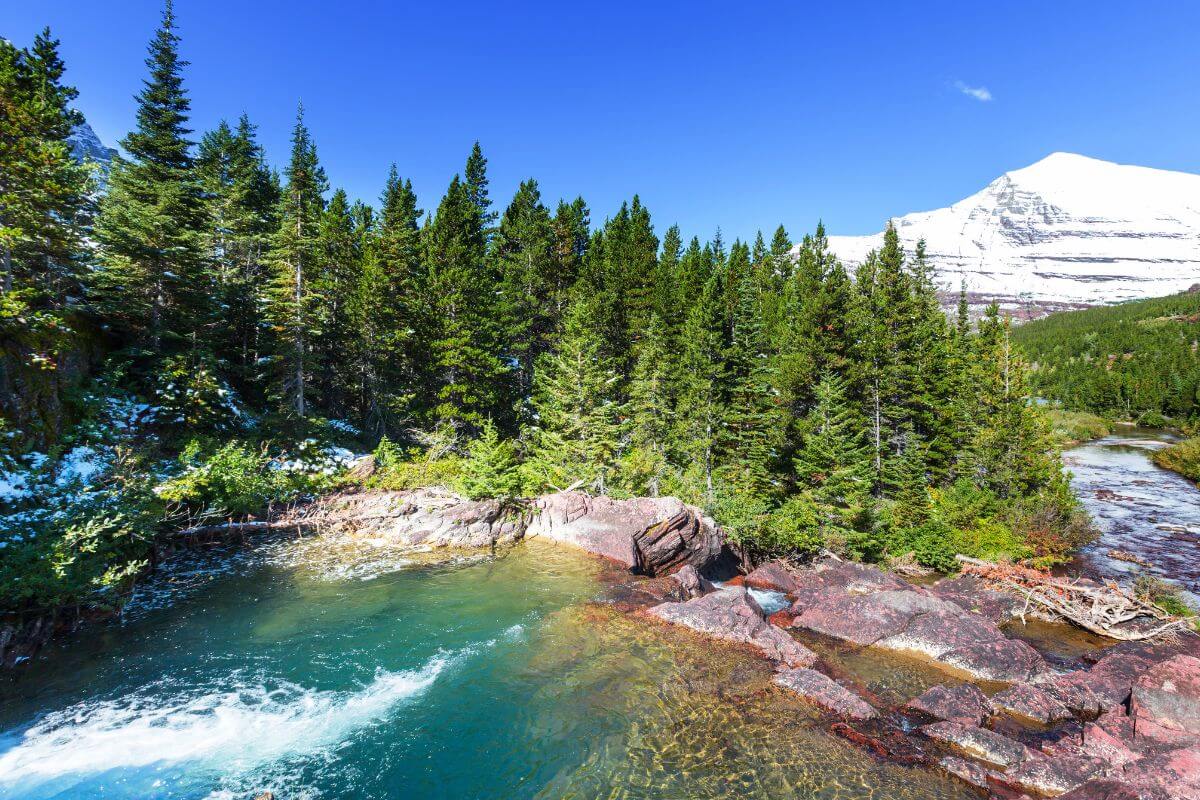Hey there, fellow travelers! Have you ever wondered if Montana is considered one of the least-inhabited states?
Well, prepare to have your curiosity satisfied and your wanderlust ignited.
Montana, with its vast open spaces and breathtaking landscapes, is a state like no other.
But what sets it apart, you may ask? It all comes down to the numbers. When it comes to its resident population, Montana takes pride in having relatively low figures, particularly versus its massive size.
But does this make it one of the least-inhabited states? That’s exactly what we’re here to explore.
- Related article: Montana Living Guide
Whether you’re planning a road trip through this captivating state or simply want to satisfy your curiosity, this article has you covered.
Are you ready? Let’s embark on this journey together and uncover the secrets of Montana’s population landscape. Hold on tight; it’s going to be a wild ride!
Population Figures: Their Importance

Population figures are important for many reasons, the main ones centering around their critical roles in the following:
- Informed Decision-Making – Population figures aid the federal government, state, and local government officials in making informed decisions concerning economic activity and the issues that impact people’s lives.
- Infrastructure Development – Population estimates are crucial for transportation authorities to expand roads and public transportation, ensuring efficient mobility for residents.
- Education Planning – Educational authorities rely on population data to assess the need for new schools in specific areas, facilitating access to quality education for all.
- Housing Planning – Planners use population figures to identify the demand for various types of housing, allowing them to address housing needs effectively.
- Future Planning – Projections based on population figures help governments prepare for future demands and challenges, ensuring efficient resource allocation.
- Data Accessibility – By making population data publicly available, the census enables journalists, students, scholars, and websites to disseminate accurate information about the population of the United States.
By harnessing the power of demographic data, governments and authorities can proactively plan for regional disparities and future demands, ultimately fostering a well-prepared and thriving society.
Montana’s Geographical Characteristics and Their Influence on the State’s Population

Montana, with its sprawling 147,040 square miles, boasts a low population density of just 6.86 people per square mile.
Despite being the 4th largest state in terms of land area, it ranks as the 3rd least dense among US states.
Additionally, with an estimated resident count of 1,122,867 as of the 2022 Census coverage, it stands as the 8th lowest in the nation in terms of population.
Its most populous city, Billings, has a resident count of 119,960, making it the state’s largest city in terms of population, accounting for 10.7% of the overall figures.
The state’s unique geographical characteristics play significant roles in shaping its population count.
Here are the different aspects of Montana’s geography and how they may influence its population count:
- Land Area – States with vast land areas, such as Montana, may have a lower population density because the population is spread out over a larger area.
- Topography – Challenging terrains, like mountains, deserts, or dense forests, can limit habitation and development, impacting population distribution.
- Climate – Harsh weather conditions, extreme temperatures, or limited access to water resources can affect population growth and migration patterns.
- Economic Opportunities – Geography can influence the availability of natural resources, agricultural land, and industries, which, in turn, can attract or deter people from settling in the area.
- Accessibility – Proximity to major cities, transportation networks, and infrastructure can affect the ease of travel and connectivity, impacting population distribution.
- Environmental Factors – Some geographic regions may be prone to natural disasters, which can affect population movement and settlement patterns.
Montana’s geography greatly influences its population distribution, creating a state known for its vast, open spaces and low population density.
US States With the Lowest Population

According to the 2022 US Census estimates, these states have the lowest populations:
| Rank | State | Population |
| 1 | Wyoming | 581,381 |
| 2 | Vermont | 647,064 |
| 3 | Alaska | 733,583 |
| 4 | North Dakota | 779,261 |
| 5 | South Dakota | 909,824 |
| 6 | Delaware | 1,018,316 |
| 7 | Rhode Island | 1,093,734 |
| 8 | Montana | 1,122,867 |
| 9 | Maine | 1,385,340 |
| 10 | New Hampshire | 1,395,231 |
The list is topped by the state of Wyoming, which is approximately 200,000 residents short of matching the city of San Francisco’s 808,437 inhabitants.
On the other end, rounding out the list is the charming state of New Hampshire.
Interestingly, North Dakota, South Dakota, and Rhode Island are also among the least populated states, each with its own unique allure.
These states may have smaller populations compared to others in the United States, but they offer a charm and tranquility that can be hard to find in more densely populated areas.
From the majestic beauty of Montana’s national parks to the quaint coastal cities of Maine, these states invite visitors to explore their natural beauty and experience a slower pace of life.
So, if you’re looking for a quieter escape, consider visiting one of the least populated states in the country.
Montana Population Figures

Whether you’re captivated by the majestic beauty of Glacier National Park, or inspired by the rich history of Native American tribes who have called this land home for centuries, Montana’s population figures reflect a deep appreciation for both its natural treasures and cultural heritage.
Montana Population by Race

Montana is a state known for its vast natural beauty and sparse population.
But what is its racial composition?
According to the latest data from the US Census, the majority of Montana’s population identifies as White Americans, accounting for approximately 88.7% of the total population.
Historically, Native Americans have also played a significant role in the state’s composition, with various Native American tribes calling Montana their ancestral home.
Today, Native Americans and Alaska Natives make up around 6.5% of the population.
African Americans in Montana comprise a relatively low 0.6% of the total population.
Similarly, the state’s Asian population remains modest, with Asian Americans representing 1.1% of the population.
We also have the Latino community, which accounts for 4.5% of Montana’s residents.
Additionally, approximately 3% of the state’s population falls under the Two or More Races category.
It’s worth noting that these percentages provide a snapshot of the current population but may have changed over time.
Montana has experienced some population growth in recent years, attracting people seeking a slower pace of life and the state’s breathtaking surroundings.
While the majority of the population is still White American, it’s possible that future demographic shifts may occur as people from different ethnic backgrounds are drawn to the state’s unique charms.
Montana Population by Age

Montana’s population is made up of diverse age groups, each contributing to the state’s unique demographic composition.
The breakdown of the population across different age groups provides insight into the age distribution of the state.
In terms of age demographics, those under 5 years account for approximately 5.1% of Montana’s population, while those under 18 years and 65 years and over constitute 20.8% and 20%, respectively.
When examining Montana’s gender breakdowns within these age groups, both males and females are fairly evenly distributed.
However, it is important to note that gender percentages can vary slightly between different age groups.
These population statistics highlight the importance of understanding the age composition in Montana.
It allows for a deeper understanding of the state’s population dynamics and can inform various aspects of public policy and resource allocation to cater to the needs of different age groups.
Montana Population by Gender

When it comes to the demographics of the state, the distribution of the population by gender paints an intriguing picture.
Montana is a state where both men and women have found their place in the wide open spaces of the Big Sky Country.
Here, the male and female populations are fairly evenly distributed, with no clear majority dominating the landscape.
The gender parity reflected across different age groups is a testament to the diverse and inclusive fabric of Montana society.
As for the sex ratio, the numbers reveal an interesting trend. While the overall balance between men and women is relatively equal, there are subtle variations when examining different age brackets.
These variations add a touch of complexity to the demographics of Montana, providing insight into the diverse needs and lifestyles of its residents.
However, it’s essential to remember that demographics are ever-evolving, and shaped by social and economic factors.
Thus, it’s crucial to consider the demographics of the state within the broader context of population trends and changes over time.
Montana serves as a prime example of a state where both men and women thrive and contribute to the vibrant tapestry of its population.
The gender distribution of 49. 3% females to 50.7% males mirrors a harmonious equilibrium, highlighting the acceptance and coexistence of diverse perspectives and experiences.
Montana Population by Education

When it comes to the demographics of Montana, education plays a crucial role in shaping the population landscape.
In the vast expanse of this beautiful state, there is a wide range of educational attainment levels among its residents.
But how does education intersect with poverty? Sadly, there is a correlation between the two.
According to statistics, the poverty rate in Montana tends to be higher among individuals with lower levels of educational attainment.
This highlights the importance of access to quality education as a means to uplift communities and combat poverty.
Taking a closer look at the numbers, we find that a significant portion of the Montana population has attained a high school diploma or equivalent.
In fact, around 94.4% of residents 25 years and over fall into this category.
Meanwhile, 33.7% of Montana’s population 25 years and over have gone a step further and earned a bachelor’s degree or higher, showcasing the commitment to higher education among Montanans.
It’s important to recognize the connection between education and opportunity.
As Montana continues to grow and evolve, investing in education will be vital to ensuring a brighter future for all its residents.
Montana Population by Income

The median household income in this vast state hovered around $60,560 in 2021, reflecting a relatively lower income level compared to the national average.
This sheds light on the economic challenges that many Montanans face on a daily basis.
Digging deeper, we uncover a concerning aspect of income inequality in the state.
The top 5% of households in Montana have average incomes that are 11 times higher than the bottom 20% and 4.3 times higher than the middle 20%.
This inequality highlights the need for policies and initiatives to bridge the economic divide and create a more equitable society.
Turning to income per capita, the numbers reveal a slightly different perspective.
Montana’s income per capita stands at approximately $34,423, hovering around the national average.
This indicates that while household incomes may be lower, individuals still have access to similar economic resources at the individual level.
As of 2021, approximately 11.9% of the Montana population lived in poverty, which is slightly higher than the US poverty rate of 11.6%.
Additionally, based on the American Community Survey’s 5-year data profile (2014-2019), males outearned females in terms of median earnings, and the primary source of household income was earnings, followed by social security.
Montana’s income demographics present a complex picture.
While the median household income and average income may be lower than the national average, the income per capita remains comparable.
Acknowledging the economic disparities and striving for greater income equality will be crucial in shaping a more prosperous future for all Montanans.
Consider the living expenses in Montana when planning your move to Big Sky Country.
Montana Population Growth and Projections

Montana has been experiencing moderate population growth in recent years.
This growth, however, is more concentrated in Western Montana, where breathtaking scenic landscapes and a tranquil existence are more likely to be found.
According to the US Census, there has been a consistent upward trend in Montana’s population over the past three years.
In 2022, the resident count reached 1,122,867, representing a 1.5% increase from the previous year.
In 2021, the population stood at 1,106,227, marking a 1.76% growth from 2020. And in 2020, there were 1,087,075 residents, reflecting a 1.58% increase from 2019.
Looking at the data provided by the Montana Department of Commerce, we can see that the state experienced an 18% population increase between 1994 and 2014, with the number of residents rising from 861,308 to 1,014,368.
This equates to a significant increase of 153,060 people.
Projections for the 2015-2025 period indicate an estimated 11% growth in Montana’s population, with residents expected to reach 1,140,625 by 2025.
This would signify an additional 117,550 residents.
However, it’s important to note that future population growth in Montana may be influenced by various factors.
One such factor is the increase in the elderly population, which could impact the overall population trend.
Additionally, major industries like agriculture and extractive industries, including the lucrative oil and gas industry, will play a significant role in shaping the population dynamics of Montana moving forward.
As Montana continues to attract newcomers with its natural wonders and peaceful lifestyle, the state’s population is projected to grow steadily in the coming years, creating new opportunities and challenges for its residents.
Montana Population Final Thoughts

Montana is one of the least-inhabited states in the US at 8th on the list in terms of lowest population and 3rd when it comes to lowest population density.
But let me tell you, being one of the least-inhabited states is far from a bad thing. In fact, it’s what gives the state its charm.
Montana is a place where you can truly escape the hustle and bustle of city life, with its majestic national parks and peaceful rural communities.
Now, don’t get me wrong, the state is not going through a population decline – quite the opposite.
The forecasted projections show a moderate growth rate in the near future. But don’t expect a significant surge in population.
But you know what? That’s perfectly fine.
That’s because Montana’s identity is rooted in its natural beauty and peaceful way of life.
When you look at the bigger picture, the state remains a symbol of untouched wilderness and tranquility. Its population may not be booming, but that’s exactly what makes it so special.
Montana Population FAQs
1. Is Montana a Great State to Live In?
Yes, Montana is indeed a great state to live in. If you long to immerse yourself in scenic beauty and surround yourself with nature each day, Montana is the place for you.
With its vast landscapes and abundance of natural resources, this state offers a unique quality of life that is unparalleled.
2. What Is Montana’s Population Density?
In terms of population density, the figures for Montana are remarkably low, with only 6.86 people per square mile. This ranks Montana as the 3rd least densely populated state in the US.
Compared to other states, Montana’s sparse population is evident in its vast open spaces and unspoiled natural beauty.
3. Why Does Montana Have a Low Population?
Montana’s low population can be attributed to a combination of historical factors and geographical characteristics.
With its large land area and low density of people, Montana faces limited economic opportunities and extreme conditions that deter people from settling in certain areas.
Additionally, poor transportation and connectivity outside of urban centers further contribute to the state’s low population.
4. What Is the Least Populated Area in Montana?
The least populated area in Montana is Ismay, a small town located in Custer County.
According to the 2020 census, Ismay had a population of just 17 residents, making it the least-populous incorporated municipality in the state.
5. What Percentage of Montana Is American Indian?
Montana’s Native American people, including Alaska Natives, make up 6.5% of the state’s population, contributing significantly to its cultural tapestry.
Montana’s commitment to preserving its rich heritage ensures the continued influential presence of this group today and in the future.
If you want to learn more about Montana, these excellent reads are full of valuable information for exploring and discovering the beauty of the state:
- https://dphhs.mt.gov/sltc/aging
- https://commerce.mt.gov/Research-Publications
- https://www.umt.edu/this-is-montana/columns/stories/montana_regions_2of3.php
- https://www.acf.hhs.gov/ana/fact-sheet/american-indians-and-alaska-natives-numbers
- https://www.cdc.gov/nchs/pressroom/states/montana/mt.htm
- https://mt.gov/discover/brief_history.aspx
- https://mhs.mt.gov/education/IEFA/1stPeoples.pdf
- https://leg.mt.gov/content/Publications/fiscal/2021-Interim/Jan-2020/Demographic-Report-FINAL.pdf
- https://opi.mt.gov/
- https://mtcf.org/womens-foundation/
- https://www.census.gov/quickfacts/fact/table/custercountymontana,MT/PST045222
- https://acl.gov/sites/default/files/programs/2016-11/Montana.pdf

